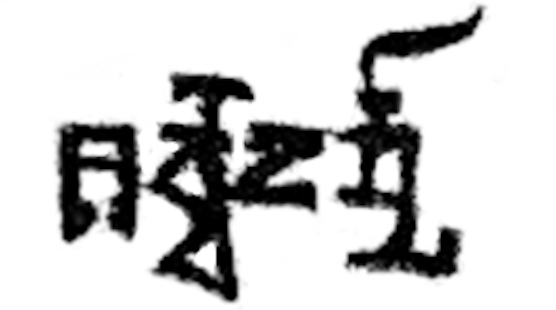Sharva-varman on:
[Wikipedia]
[Google]
[Amazon]
 Sharvavarman (
Sharvavarman ( ''Śa-rvva-va-rmmā'', complete form: ''Śarvavarman Indra Bhattarika'') was a ruler of the
''Śa-rvva-va-rmmā'', complete form: ''Śarvavarman Indra Bhattarika'') was a ruler of the
 Sharvavarman (
Sharvavarman (Brahmi script
Brahmi (; ; ISO 15919, ISO: ''Brāhmī'') is a writing system of ancient South Asia. "Until the late nineteenth century, the script of the Aśokan (non-Kharosthi) inscriptions and its immediate derivatives was referred to by various names such ...
: 𑀰𑀭𑁆𑀯𑁆𑀯𑀯𑀭𑁆𑀫𑁆𑀫𑀸 , Gupta script
The Gupta script (sometimes referred to as Gupta Brahmi script or Late Brahmi script)Sharma, Ram. '' 'Brahmi Script' ''. Delhi: BR Publishing Corp, 2002 was used for writing Sanskrit and is associated with the Gupta Empire of the Indian subcon ...
:  ''Śa-rvva-va-rmmā'', complete form: ''Śarvavarman Indra Bhattarika'') was a ruler of the
''Śa-rvva-va-rmmā'', complete form: ''Śarvavarman Indra Bhattarika'') was a ruler of the Maukhari dynasty
The Maukhari dynasty (Gupta script: , ''Mau-kha-ri'') was a post-Gupta dynasty who controlled the vast plains of Ganga-Yamuna for over six generations from their capital at Kannauj. They earlier served as vassals of the Guptas and later of Harsha ...
of Kannauj
Kannauj (Hindustani pronunciation: ənːɔːd͡ʒ is a city, administrative headquarters and a municipal board or Nagar Palika Parishad in Kannauj district in the Indian state of Uttar Pradesh. The city's name is a corrupted form of the cla ...
. He ruled circa 560-575 CE and had the title of " Mahārājādhirāja", "King of Kings" i.e. "Emperor".
Shavavarman may have been the greatest of the Maukhari emperors, invading Magadha
Magadha was a region and one of the sixteen sa, script=Latn, Mahajanapadas, label=none, lit=Great Kingdoms of the Second Urbanization (600–200 BCE) in what is now south Bihar (before expansion) at the eastern Ganges Plain. Magadha was ruled ...
circa 575 CE and defeating the Later Guptas
The Later Gupta dynasty ruled the Magadha region in eastern India between the 6th and 8th centuries CE. The Later Guptas succeeded the imperial Guptas as the rulers of Magadha, but there is no evidence connecting the two dynasties; these appear ...
kings Damodaragupta and Mahasenagupta, which made him ruler of the entire Uttar Pradesh
Uttar Pradesh (; , 'Northern Province') is a state in northern India. With over 200 million inhabitants, it is the most populated state in India as well as the most populous country subdivision in the world. It was established in 1950 ...
.
Asirgarh and Nalanda seals
Shavavarman was the son of Ishanavarman. He and the chronology of his family are rather well known, because of a copper seal he created: the Asirgarh seal. The seal reads: Several other nearly identical seals of Sharvavarman were also discovered inNalanda
Nalanda (, ) was a renowned '' mahavihara'' ( Buddhist monastic university) in ancient Magadha (modern-day Bihar), India. The content of the seals is identical, but small variations indicate that they come from different molds.
 Sharvarman was an important rival of the Late Guptas king Mahasenagupta (r. c. 562-601 CE) during the period 575-585 CE.
With the end of Hunnic power in India, new contacts were established between India and the Sasanian Empire. Intellectual games such as
Sharvarman was an important rival of the Late Guptas king Mahasenagupta (r. c. 562-601 CE) during the period 575-585 CE.
With the end of Hunnic power in India, new contacts were established between India and the Sasanian Empire. Intellectual games such as
Reign
 Sharvarman was an important rival of the Late Guptas king Mahasenagupta (r. c. 562-601 CE) during the period 575-585 CE.
With the end of Hunnic power in India, new contacts were established between India and the Sasanian Empire. Intellectual games such as
Sharvarman was an important rival of the Late Guptas king Mahasenagupta (r. c. 562-601 CE) during the period 575-585 CE.
With the end of Hunnic power in India, new contacts were established between India and the Sasanian Empire. Intellectual games such as chess
Chess is a board game for two players, called White and Black, each controlling an army of chess pieces in their color, with the objective to checkmate the opponent's king. It is sometimes called international chess or Western chess to dist ...
and backgammon
Backgammon is a two-player board game played with counters and dice on tables boards. It is the most widespread Western member of the large family of tables games, whose ancestors date back nearly 5,000 years to the regions of Mesopotamia an ...
demonstrated and celebrated the diplomatic relationship between Khosrow I
Khosrow I (also spelled Khosrau, Khusro or Chosroes; pal, 𐭧𐭥𐭮𐭫𐭥𐭣𐭩; New Persian: []), traditionally known by his epithet of Anushirvan ( [] "the Immortal Soul"), was the Sasanian Empire, Sasanian King of Kings of Iran from ...
and a "great king of India." The vizier of the Indian king invented chess as a cheerful, playful challenge to King Khosrow. It seems that the Indian ruler who sent the game of chess to Khosrow may have been Śarvavarman, between the beginning of Śarvavarman's reign in 560/565 and the end of Khosrow's reign in 579, When the game was sent to Iran it came with a letter which read: "As your name is the King of Kings, all your emperorship over us connotes that your wise men should be wiser than ours. Either you send us an explanation of this game of chess or send revenue and tribute us."Canepa 2009, p. 181 Khosrow's grand vizier successfully solved the riddle and figured out how to play chess. In response the wise vizier created the game backgammon and sent it to the Indian court with the same message. The Indian king was not able to solve the riddle and was forced to pay tribute.
Sharvavarman was succeeded by his son Avantivarman, as indicated by the "Sohanag seal of Avantivarman".
References
Works
Modern works
* {{DEFAULTSORT:Ishanavarman 6th-century Indian monarchs